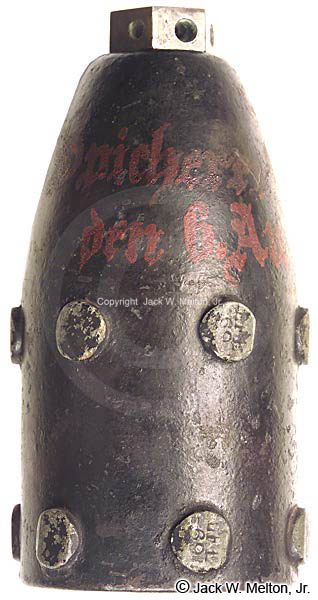French
Unknown Inventor
DIAMETER: 3.325 inches not including studs
GUN: 3.4-inch French rifled gun
LENGTH: 6 1/4 inches
WEIGHT: 8 pounds
CONSTRUCTION: Shell
SABOT: Zinc studs
FUZING: Threaded time fuze (brass)

The projectile used in the
French field-service is made of cast-iron, and has twelve zinc studs on its
sides, arranged in pairs, so as to fit the
six grooves of the gun. For the larger cannon-projectiles but three studs
are used, and these are cast on the projectile, nearly opposite to its
center of gravity; the bearing sides of the studs are faced with white metal
to diminish friction against the grooves of the bore. The shape of the
grooves is such as to center the projectile. The latter projectile is used
with increasing, the former with grooves of uniform, twist. Russian,
Austrian, and Spanish artillery projectiles belong to this studded or button
class, but differ from each other in the details of their construction.
in pairs, so as to fit the
six grooves of the gun. For the larger cannon-projectiles but three studs
are used, and these are cast on the projectile, nearly opposite to its
center of gravity; the bearing sides of the studs are faced with white metal
to diminish friction against the grooves of the bore. The shape of the
grooves is such as to center the projectile. The latter projectile is used
with increasing, the former with grooves of uniform, twist. Russian,
Austrian, and Spanish artillery projectiles belong to this studded or button
class, but differ from each other in the details of their construction.